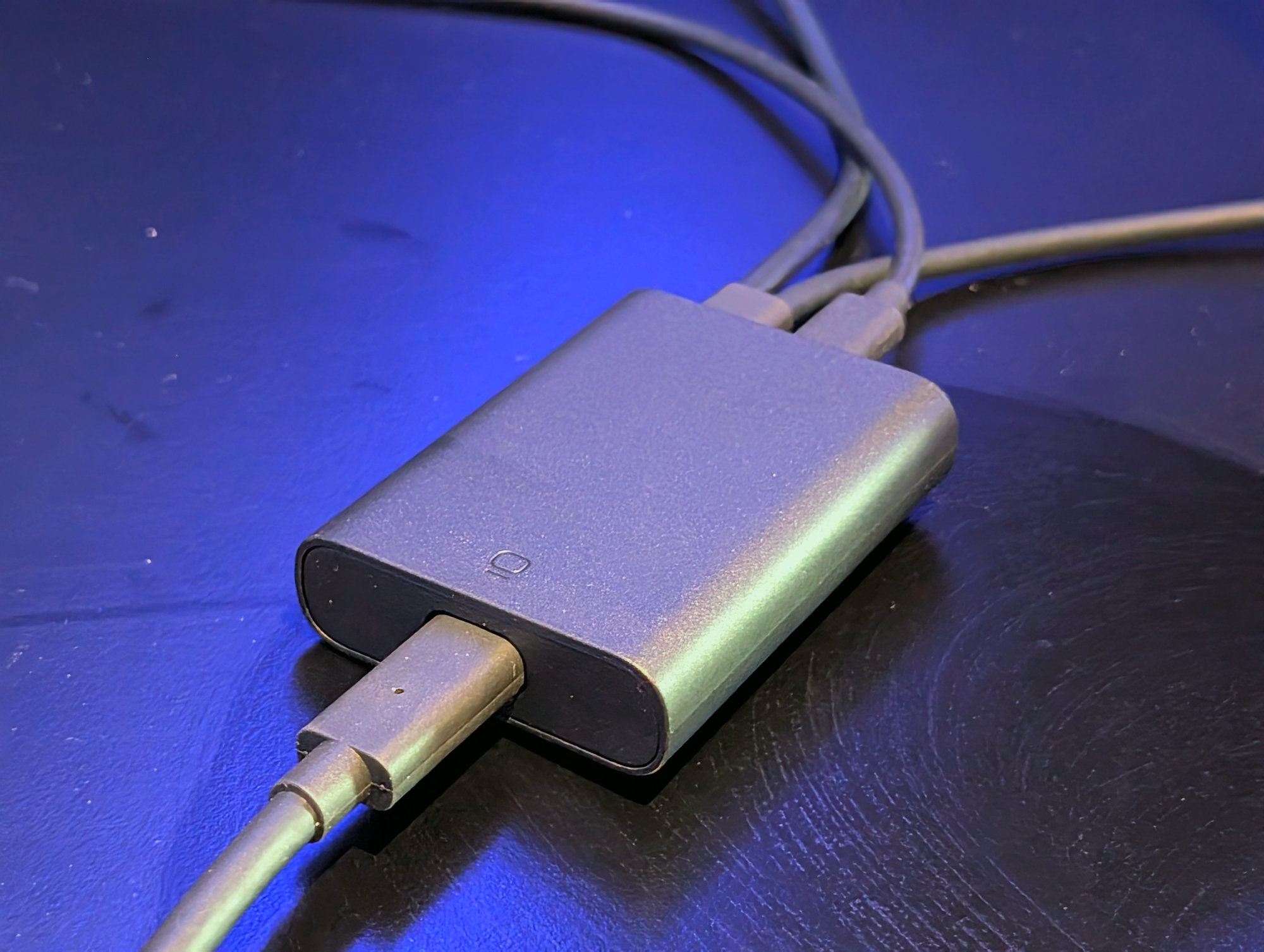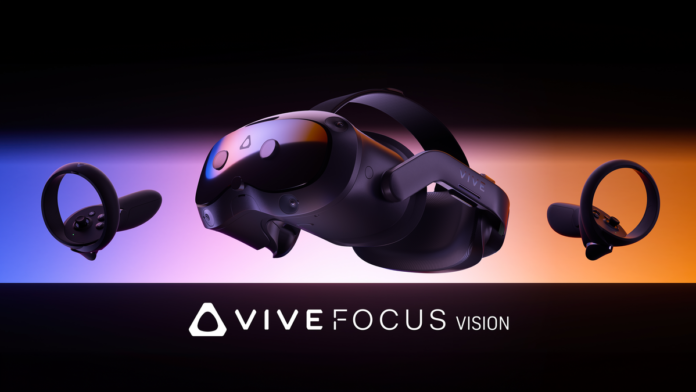We recently got to work with Vive Focus Vision, HTC’s latest headset launching today.
If you missed the announcement last month amid all the Meta and Pico news, Vive Focus Vision is a refresh of Vive Focus 3 with color passthrough, eye tracking, more RAM, and support for lossless PC VR via a DisplayPort adapter.
While Vive Focus 3 was officially only sold to businesses, HTC also markets Vive Focus Vision to consumers, mostly as a PC VR headset via the $150 DisplayPort accessory. HTC’s pitch here is that for $1150 you get a headset with a higher resolution than Quest 3 and Pico 4 Ultra, with integrated eye-tracking and lossless PC VR.
Does all this make Vive Focus Vision the new PC VR headset par excellence? I attended HTC’s launch event to find out.
Vive Focus Vision has eye tracking and DisplayPort PC VR
HTC just announced Vive Focus Vision, a refresh of Vive Focus 3 with color passthrough, eye tracking, a DisplayPort PC VR add-on, and more.
In terms of comfort, Vive Focus Vision feels exactly the same as its predecessor. It is hefty, with a total weight of almost 800 grams, but that weight is very well distributed, with the battery behind the thick rear padding and not in the sight itself. It never felt uncomfortable during the time I was on it, although I didn’t wear it for more than 45 minutes at a time.
I wasn’t able to try out Vive Focus Vision’s passthrough at this event, but the lighting in the room was very dim, so I’m not sure it would have been a meaningful test. And in the context of PC VR, this doesn’t really matter.
HTC had three demo stations set up, one running Automobilista 2 and the other two running Arizona Sunshine 2. All three used the DisplayPort adapter for lossless PC VR.
On both Arizona Sunshine 2 demo stations, I immediately noticed a strange problem where a display frame would drop every few seconds when I turned my head. Most VR users today have never seen a real drop in display frame, as modern VR compositors rotate to reproject the old frame to eliminate them. When Oculus’s Asynchronous Timewarp introduced this technology in 2015, it was a big deal. Even a single screen frame dropping in VR is noticeable and jarring, and that was the case here.
HTC told me this was an issue with a pre-release version of the cable, and claimed it wouldn’t be an issue in the shipping version. The third demo station, which ran the racing game Automobilista 2, didn’t have this problem, so I spent most of my time playing.

As with Sony’s for PlayStation VR2, HTC’s adapter takes an included 5-metre USB-C cable from the headset on one end, and DisplayPort, USB-A and AC power on the other.
Powered by an RTX 4090 laptop, the combination of the 2448×2448 panels and lossless video signal delivered image quality that was a noticeable step above the compressed Quest 3 setup I usually use for VR sim racing, with truly impressive details – at least in the center of the lens. Vive Focus Vision continues to use Fresnel lenses and not pancake lenses, which complicates the question of visual quality. As with all Fresnel lenses, you’ll see noticeable blur anywhere outside the center of the lens, and in practice this means turning your head more and your eyeballs less.
In the context of sim racing, however, this wasn’t a dealbreaker by any means, and in fact preferable to the lower resolution and compressed visuals of a Quest 3 on PC VR. And don’t be so quick to lump Vive Focus Vision in with the other new Fresnel lens headset, Quest 3S. Vive Focus Vision’s eye-tracking and motorized lenses work together to automatically align the lenses horizontally almost perfectly with your eyes, meaning the optical fit is much better than being limited to just three steps.
In PC VR titles that support dynamic rendering via third-party tools like OpenXR Toolkit, Vive Focus Vision’s eye-tracking should also allow you to boost quality beyond what you’d get without headsets. However, Automobilista 2 is not one of those titles, and your mileage may vary if you use such tools.
The most common use of Vive Focus Vision’s eye tracking in the consumer space, aside from automatic IPD adjustment, will likely be controlling avatar eyes in VRChat. With HTC’s $100 Vive Facial Tracker add-on, VRChat enthusiasts can also add face tracking, and with a few hundred dollars extra on Vive Ultimate Trackers they can even add body tracking.
So far I’ve focused on Vive Focus Vision as a PC VR headset, since that’s mainly how HTC offers it to consumers. Yes, it works completely standalone too, but the store only carries a small portion of what you’d find on Quest or even Pico, so I doubt more than a handful of consumers will care. Even in the corporate world, Focus 3 was more commonly used as a wireless PC VR headset than as a standalone headset, and I don’t expect this trend to change with Focus Vision. This is probably why HTC chose to add new features instead of upgrading the XR2 chipset.
| HTC Vive Focus vision |
Meta Quest 3 |
Sony PlayStation VR2 |
|
| Lens type | Fresnel | Pancake | Fresnel |
| Display type | LCD screen | LCD screen | OLED |
| Pixels per eye | 2448×2448 (RGB) |
2064×2208 (RGB) |
2000×2040 (Pen tile) |
| Eye tracking On PC |
✅ | ❌ | ❌ |
| Wireless PC VR |
H.264/HEVC via Wi-Fi 6E |
H.264/HEVC/AV1 via Wi-Fi 6E |
❌ |
| Wired PC VR |
Original via DisplayPort ($150 adapter) |
Compressed via USB |
Original via DisplayPort |
| Eye relief Amendment |
❌ | ✅ | ✅ |
| Band type | Rigid plastic | Lap (Replaceable) |
Halo belt |
| PC VR price | $1000 (+$150 DP adapter) |
$500 | $550 + Adapters |
So let’s return to the question that prompted this article: is Vive Focus Vision the new PC VR headset of choice?
If you’re a PC VRChat user and want to track your eyes and expressions, but might not like Quest Pro’s compression artifacts. But if you don’t care about eye-tracking, you can get even higher resolution with better lenses at a lower cost with Pimax Crystal Light, or get the rich colors and contrast of OLED with PlayStation VR2’s PC adapter. And of course, if you’re okay with compression, you can just grab a Quest 3 or Pico 4 Ultra and enjoy watching with your eyes instead of always turning your head.
The problem for HTC is that even as a PC VR headset, Vive Focus Vision faces stiff competition, and it’s unclear how many consumers care enough about its unique features to jump in.





